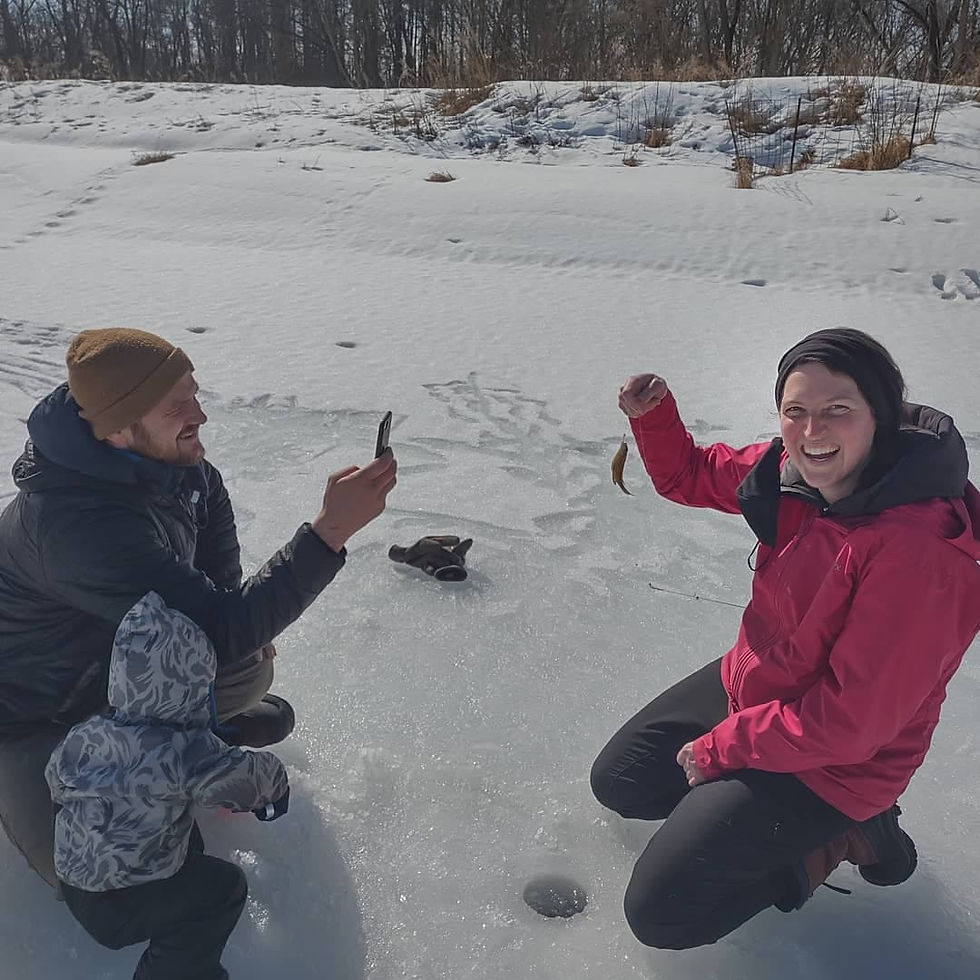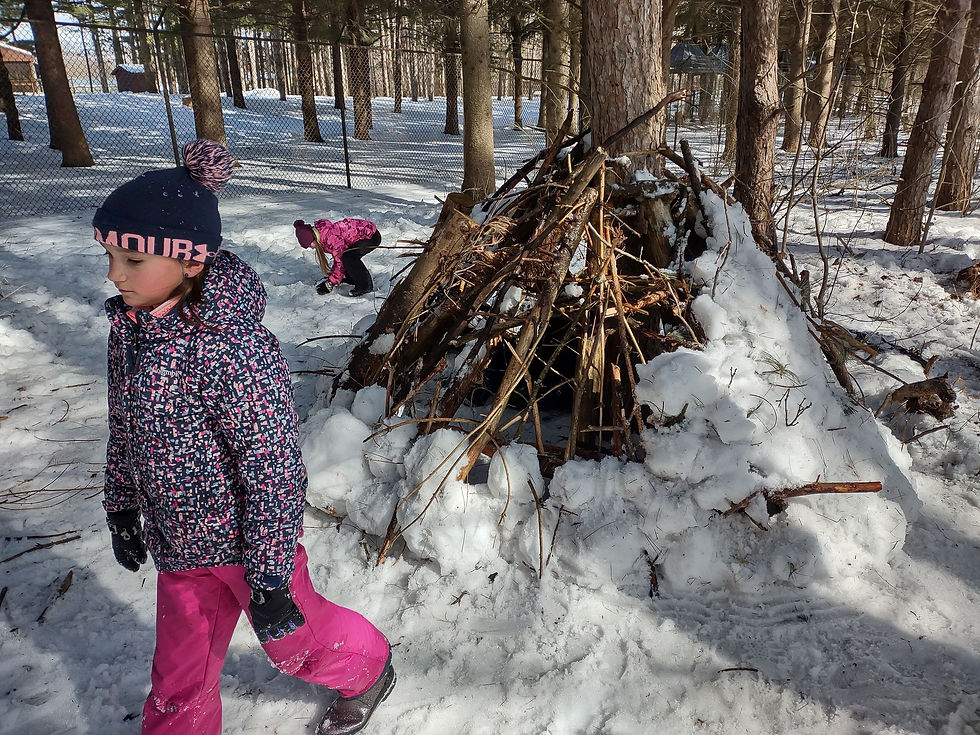Habitat Projects Slated for 2021
- Kenny Slocum

- Mar 1, 2021
- 7 min read
At the end of December, we outlined in this blog some of the habitat improvement projects into which we sunk our teeth (metaphorically and literally when the chainsaws got involved) in 2020. This month I’d like to take some time to look ahead with no small amount of excitement to some of the projects laid out for us in 2021. First on the docket, a major expansion of the prairie restoration on Osborne Park’s north side, along the road leading to the archery range and along the disc golf course. The CCCB will be using funds coming from a habitat management grant given out through the Iowa DNR’s wildlife diversity program, which is in turn funded in part by the Chickadee Check Off. This competitive program aims to improve habitat specifically for non-game species in accordance with state’s wildlife action plan. At a casual glance, you may not notice where the existing reconstruction ends and the “weedier” area begins, but the animals certainly do. Presently, the site in question consists of mostly smooth brome, some goldenrod, Queen Anne’s lace, common milkweed, and the like. It looks like a grassland. But it is vastly different – and less supportive of a diverse mix of butterflies, bees, and birds – than the reconstruction next door.

Part of what makes this “grassland” a good candidate for a major overhaul stems from the diligent work of DNR staff in documenting the species found at Osborne. During a 2017 survey, the wildlife professionals identified two species from Iowa’s endangered species list: the Henslow’s sparrow, and variable darner, a type of dragonfly. Recognizing the area sensitivity (i.e. requiring a minimum area to colonize and breed) of those species, this project will nearly double the size of the reconstruction, creating a contiguous block of quality habitat for all manner of buzzing and chirping critters.

To prepare a site for a brome-to-prairie conversion, it’s ideal to actually start by converting the brome to soy beans for a few years. Yes, it may sound strange for a conservation board to advocate converting perennials to annual row crops, but it’s the best way to starve the seed bank and vegetative reproduction of the brome while minimizing the use of chemicals.
Unfortunately, on the heavily-sloping and poor soils (for crops) underlying the site, that route isn’t an option. So we will start with a burn in the very early season, followed by a termination of the resprouted grasses once they emerge. We’ll terminate again, and repeat the process until the fall, when hopefully the existing root systems are starved and the site should be ready to receive a seeding of native grasses and forbs.

Later on in the year, we’ll turn our attention from the prairies to the woodlands with an expansion of last year’s work at the Becker West wildlife area. Using funds from the DNR’s habitat stamp grant program, the CCCB will bring out a crew from the Conservation Corps of Iowa in the fall to remove the brush and small trees from the degraded savanna habitat on the rugged terrain of the site’s west side. When it’s all said and done - “done” being a relative term in the habitat restoration world – the site will have a beautiful mosaic of reconstructed prairie, conservation hayfield, restored savannas, riparian shrubland, and mature timber.

The savanna restoration work of this year and last has allowed for a return of prescribed fire to the site, and we look forward to watching the gradual transition to a more representative ecology that will better tell the story of the ancient oaks, rock shelters, and deeply incised valleys presently hidden behind the last few decades of invasive species growth and forest succession.
Last but not least, we were fortunate enough to have two applications to the DNR’s fish habitat grants program funded this year. One will be an expansion of the recent improvement where the Osborne Nature Trail meanders along the banks of the Volga River. In 2019, the addition of a bankfull bench, bank armoring, and boulder clusters did wonders to deepen the channel and create refugia for fish species conspicuously absent from this stretch of river for the last few years.
In 2021, now secure in the knowledge that the intervention seems to work pretty well for holding fish and mitigating erosion, we will nearly double the length of those treatments. Larger areas of contiguous habitat are critical for maintaining and expanding wildlife populations whether they dwell on land, air, or sea, and by building on the existing habitat it’s hoped that Osborne Park’s stretch of the Volga will provide a core area of fish production that will improve the health of the whole river.

At the far southwest edge of the county, Joy Springs county park will see a few major improvements along the trout stream traversing the campground area. This park has proved remarkably popular with trout anglers in the age of social distancing, but there’s certainly room for improvement. A few stretches of the stream have suffered sluffing banks, heavy sedimentation, and a lack of structure.
With the help of the DNR, we’ll hope to assuage some of those issues with cross vanes, armored banks, and large tree root wads placed along stream banks. These structures should help alleviate some of the erosion issues while providing structure and cover for fish. The cross vanes will help concentrate the stream’s energy into a smaller area, creating scouring and a deeper channel that will allow for a little escape from the summer heat and a more natural self-cleaning regime of the stream’s sediment.

Did you notice a theme here? All of these projects came through Iowa DNR grant programs. These funds come from YOU, the license-buyers, hunters, anglers, and chickadee checker-offers. Think about that return on investment for your deer tags, fishing licenses, and trout stamps! This year will see more than $30,000 go into habitat projects in Clayton County alone, with other projects going on throughout the state thanks to those dollars. Rest assured that these competitive programs see many worthwhile projects go unfunded every year.
If you ever wonder what you’re paying for when you throw down the price of a large pizza to fish all year long or buy a deer tag, well, this is it. Take a look at the rainbow trout you pull out on an unforgettable morning rippin’ lips. They don’t get stocked if these programs aren’t funded. Take a look up and down the stream bank. Odds are, there’s a bank hide, J-hook, or boulder cluster that came from those license sales. If you've bagged a pheasant on an upland prairie, odds are, that prairie is a reconstruction, and it didn't happen for free. Of course, you may not see the signs of human input – particularly if it was done right.

Which brings me to my last point: we want an omelet. Now, you can have a pretty good omelet with just eggs and cheese – and that’s what we often have with a sluffing-banked, sandy-bottomed stream. That’s what we have with a masked oak savanna overgrown with young maples and ironwood. That’s what we have with a stand of smooth brome and generalist native species. There’s wildlife there; it’s certainly better than a parking lot, but these places hardly harbor the diversity and abundance they could with a careful addition of the right ingredients.
I like an omelet with spinach, and garlic, and peppers and onions and all the fixin's. But to get it, I’ve got to break some eggs, chop some veggies, and spend a little more time making a mess in the kitchen. That’s what we’ll be doing this year – breaking eggs, chopping, and simmering our way to something much more complete and nutritious. For a while, there might be a mess while the dish comes together. But we promise, years from now, the omelet will be cooked, the dishes washed, and visitors will have nothing left to do but sit back and savor.
Looking Back
February packed a lot into such a short month... Arctic intrusions, heavy snows, and unseasonable warmth all in the span of 28 short days! Naturalist Abbey Harkrader continued her wonderful "Nature All Around Us" art series with a guided painting session. Just look at those beautiful owls! Either these were the right students or Abbey's a great teacher.

On February 27th, a great program turned into a little bit of citizen science with Snowfest, a combination ice fishing/snowshoeing clinic at the Osborne Pond. The pond was recently rehabilitated with, again, fish habitat program funding, and it was fun to see how the recently-stocked fishies are coming along!

However, one surprising discovery did put a slight damper on the otherwise beautiful afternoon.

Nice fish, right? Except, it's a crappie. Crappie were never stocked into this pond by the IDNR. Certainly there are possible natural means by which fish find their way to closed off bodies of water, but please do not try to help the DNR by stocking fish personally. Stocking fish is not as simple as "dump in fish we like to catch." It is a sensitive science, and adding fish thoughtlessly can throw the entire ecological mechanics out of whack, making it difficult to establish a healthy, enjoyable fishing pond. Tell your friends, and don't dump bait!
February also proved a great month for hosting some Hatchet-inspired field days. As always, the students had a great time building shelters, snowshoeing, identifying scat, and learning survival skills. The survivalists demonstrated considerable variability in their capacity to build decent shelters, but a few looked downright cozy once insulated with the wonderfully packable snow!

Looking Forward
March will be a busy one! It'll be the time to start keeping an eye on the forecast for potential burn windows, and a gradual ramping up of activity at our parks and campgrounds.
On March 13th, we will host our annual bluebird house workshop. Participants will build their own house to take home, and learn a little about how to care for it. Class size is limited, so call the Osborne Nature Center to lock up a spot!
On March 18th, Older, Wiser, Livelier Souls (O.W.L.S.) will rejoin the CCCB's program offerings. The first walk will take place at the Sny Magill unit of Effigy Mounds National Monument. Call Osborne to reserve a spot as space is limited for this event.
That Saturday, on March 20th, a big hullabaloo will be going down at the Motor Mill Historic Site! The Motor Motor 5K/10k trail runs will comingle with the official grand opening of the Motor Mill trail connecting Elkader to Motor Mill! If you want to make some of the first tracks on the new trail, sign up for the 10K. If you want to short and sweet (sorry, I meant steep), stick to the dirty, rocky, rooty 5K route. Registration available on this website under the "events" tab.
Finally, on March 26th, the Nature All Around Us art series will continue with the creation of pine needle baskets. Get those digits ready for some fine motor skills, and call soon to reserve a spot.
In further news, we have joined the Instagram world! Follow @ClaytonCountyConservation for pretty pictures and such.




Comments